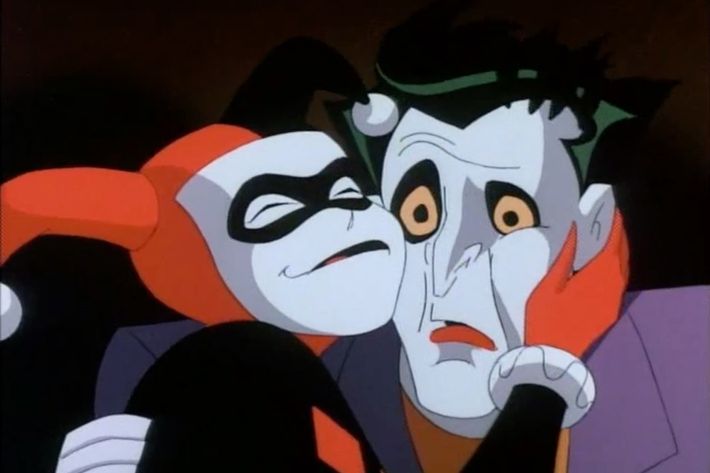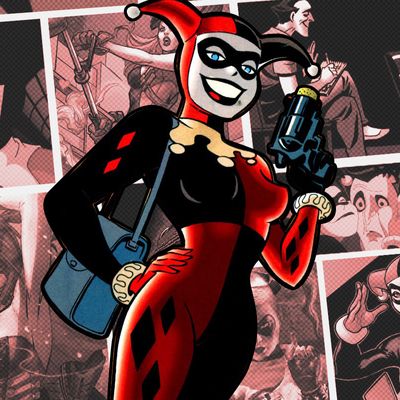
This story originally ran in 2015, just before Harley Quinn reached new heights of popularity via appearances in three movies and her own animated series. We’re republishing it now following the death at age 67 of Arleen Sorkin, who originally voiced — and inspired — the character.
The comics industry is in the midst of a golden age for admirable female role models. Every few months, we get more series starring women worth looking up to: superheroes who work to fight sexism in the workplace by day and evil by night, hard-boiled detectives who battle to avert crises both public and personal, teenagers trying to build a kinder world free of prejudice. But there’s a fly in the ointment, and she’s wearing clown makeup.
Harley Quinn is the best-selling female character in comics, and she’s casually homicidal, gleefully amoral, and mentally unbalanced. There was a time when she was a mental-health professional, but she shredded her Hippocratic Oath when she hopped into bed with a mass-murdering, psychopathic patient and began a crime spree that would make Bonnie and Clyde wince. In the 22 years since she first entered our world as a one-off character in a Batman cartoon, she’s occasionally made the world a better place — but it’s usually by accident and never for truth, justice, and the American Way.
No one could have predicted that Harley would last beyond her first appearance, much less become the title character in a series that cracks the best-seller charts every month. Her real-world path to icon status is bizarre and unprecedented in the superhero ecosystem. But here she is: Jewish, queer, morally questionable, deeply imperfect, and beloved by millions. The company that owns her, DC Entertainment, has declared February 2015 to be “Harley Quinn Month,” and now is the perfect time for us to ask whether Wonder Woman is comics’ biggest female icon anymore. (And, if Harley’s superfans are to be believed, she’s even more of a feminist character than the venerable Amazon.) Here, then, is the strange, hidden story of Harley Quinn, the superhero world’s most successful woman — who she is and how she came to be.
Writer Paul Dini is credited as the creator of Harley, and that’s technically true. He came up with the character while he was writing for the acclaimed Batman: The Animated Series in the early ‘90s. But the true origins of Harley Quinn lie years earlier, in the mind of the actress who voiced her on the cartoon: Arleen Sorkin.
In 1987, Sorkin was a regular on the soap opera Days of Our Lives, playing the show’s comic relief: the ditzy, leggy, Noo Yawk–accented Calliope Jones. But unlike her flighty character, Sorkin was a skilled and experienced comedy writer. “I could never just come in and run my lines,” she told Vulture. “I was forever suggesting stuff, probably out of boredom!” So when she went to a screening of the faux-medieval The Princess Bride, an idea struck her: Why not do a fairy-tale dream sequence on Days? The producers were into it and aired an episode in which Calliope acts as a court jester, roller-skating into a throne room and doing some hackneyed borscht belt gags for a royal family.
Dini and Sorkin were college friends, and one day, she gave him a VHS tape of her favorite Days moments — including her jester bit. The tape sat idle for years. But in mid 1991, Dini was sick as a dog and popped the tape into his VCR. He was a budding television writer at the time, cranking out freelance scripts for the as-yet-unaired Batman: The Animated Series. He’d been struggling to come up with a female character to use as a one-off in an episode about Batman’s archnemesis, the Joker.
“I thought, Maybe there should be a girl there,” he said. “And I thought, Should the girl be like a tough street thug? Or like a hench-person or something? And then suddenly the idea of someone funny kind of struck me.” When he saw Sorkin in clown makeup, the pieces fell into place, and he came up with a silly little sidekick. He gave her the comic-book-y name of Harley Quinn, sketched out an idea for her look, and brought the sketch to the cartoon’s lead artist, Bruce Timm.
“He did do a rough design for her, which was, frankly, not very good,” Timm recalled. “It had a weird ‘60s kind of vibe to it. It was just odd. Charming, but odd. I thought we could improve on that. So I immediately started researching traditional harlequin gear and did kind of a simplified super-villain version of that. It was always intended to be just a one-off.” Nevertheless, Timm was — and is — a perfectionist and labored to give this cameo character a distinctive look: a red-and-black full-body jumpsuit adorned with playing-card diamonds, ruffled cuffs, and a dual-pronged jester’s cap.
Dini invited Sorkin to record the voice for the character she’d inspired. Sorkin had left Days of Our Lives and was game for some work, especially if it just involved a few hours in a recording studio. She was committed on the microphone but didn’t put a whole lot of work into preparation. “I picked a voice that came easily,” she said. It was, in essence, her own voice: high-nasal, sing-song-y, and filled with Brooklyn-ish inflections.
“It is to laugh, huh, Mistah J?” Harley says to the Joker in her first-ever line of dialogue in that fateful 1992 episode “Joker’s Favor.” Right away in that rhetorical question, we get some of the elements that have stood at Harley’s core ever since. For one, she’s full of nicknames and delightfully early-20th-century idioms (“It is to laugh,” in this context, basically means “Ain’t that the truth”). Most important, she’s immediately expressing a kind of sycophantic devotion for superhero fiction’s preeminent bad guy.
But she was more than just a plot device, even in that first episode. Sure, she was partially an homage to the villains’ molls from the campy ‘60s Batman TV show, but Harley wasn’t content to be eye candy. “Hey, sugar, you wanna read me my rights?” a cop asks her at one point. “You have the right to remain silent!” she barks, before she kicks him in the shin, hard, and mutters, “Jerk.” She’s even aware of the gender stereotypes that a viewer might saddle her with: During the episode’s climax, Harley plays on Batman’s paternalism in an attempt to distract him, making doe eyes and saying, “I know, you’re thinking, What a shame! A poor, innocent, little thing like her, led astray by bad companions!” (She then grabs a knife and tries to stab him.) She’s also straight-up delightful: an acrobatic sprite, prone to shouts, disguises, and reciting poems before her boss tries to murder police officers.
Cartoons have no single auteur, and the minds that contributed to “Joker’s Favor” were as shocked as anyone when they saw what they’d created. “When that first episode she appeared in came back from overseas and we saw her animated, with the combo of the visual and Arleen Sorkin’s performance, y’know, it was kind of magical,” Timm said. “Paul started immediately planning her return and saying, ‘Y’know what? I’m gonna bring that Harley Quinn character back.”
Dini didn’t just bring her back. Over the next seven years, Dini, Timm, and Sorkin built Harley into one of the most memorable Batman characters of all time. That was no small trick, given that the Batman mythos was already more than 50 years old and had featured the same general cast of archetypes for decades. It was made all the more remarkable by the fact that she didn’t even exist in the mainstream Batman comics of the time — it was all happening on a kids’ TV show and its spinoff products. And even though children were the target audience, Harley’s story lines were provocative in ways no other Batman tales had been.
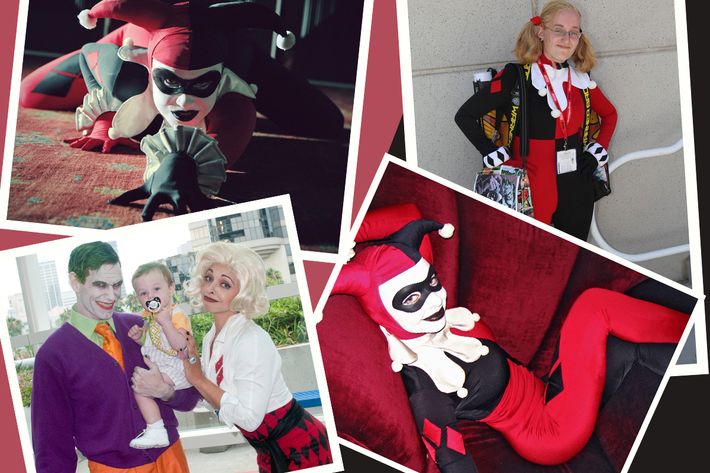
Harley stories grappled very directly — albeit in exaggerated, cartoonish fashion — with cycles of domestic violence. In classic episodes like “The Laughing Fish,” “Harley and Ivy,” and “Harlequinade,” Harley and the Joker map out a fascinating power dynamic. Like all great superhero-fiction relationships, Joker and Harley’s followed a template. At the start, Harley is head over heels for Joker, but he treats her like dirt. Then they separate, usually because Joker kicks her out or Harley decides she’s had enough. Harley strikes out on her own or shacks up with fellow villainess Poison Ivy (Dini strongly implied that Harley and Ivy have a sexual relationship, and this fact is more or less canon by now, though DC never officially confirms it). Harley fluctuates between pining for Joker and cursing his name. Joker realizes something’s missing from his life without his gal. Then some explosive turn of events reunites the murderous twosome. There were all kinds of variations, but the core outline became like a Punch and Judy show: cyclical, violent, and compellingly simple.
There are a pair of transcendent moments in the season-two episode “Harlequinade” that come as close as any to encapsulating the tragedy, comedy, and magic of the Harley-Joker romance. Harley, separated from the Joker after an arrest (he’s noticeably unconcerned with getting her out), agrees to help Batman on a caper in exchange for a full pardon. At a gangster hideout, she has to create a diversion to allow Robin to break into the building. When the lead mobster says he doesn’t understand why Harley sticks with the Joker, she leaps in front of the hideout’s in-house band and begins to sing. It’s an obscure novelty song from the 1940s, “Say That We’re Sweethearts Again,” filled with lyrics like, “I never knew that our romance had ended / until you poisoned my food” and “Won’t you please put down that acid?” As Sorkin croons, it’s hard to know whether you should laugh or cry.
Harley holds everyone’s attention with a vaudevillian flair. She’s feminine but not objectified. She’s in charge of the entire room. And yet, she still misses her soul mate, no matter how awful he might be to her.
By episode’s end, the two are reunited, but in a way that could only happen to Joker and Harley. Joker tries to blow up Gotham and — to Harley’s shock — is willing to leave her behind as he flies away in a biplane. Harley, furious, shoots a jester-shaped toy at the cockpitted Joker, yelling, “Laugh this off, puddin’!” Joker crashes, and Harley saves the day (though she only did so out of rage toward her scornful lover). She walks up to him, armed with a machine gun. Ever the emotional abuser, Joker taunts her: “You don’t have the guts. Not in a million years would you— ” Harley cuts him off by pulling the trigger, her eyes welling with tears. But a comical sign reading “RAT TAT TAT” is all that comes out of the barrel. Surprised, Harley gives a sheepish grin. Joker’s scowl abruptly turns into a smile.
“Baby, you’re the greatest!” he shouts. This act of violent defiance has rekindled his love. She squeals and runs into his arms. Even F. Scott and Zelda would blush. (It’s also worth noting that their star-crossed romance was inter-ethnic: Harley was written as Jewish, often uttering yiddishkeit words like plotz. As Sorkin put it: “At least we know the Joker isn’t an anti-Semite!”)
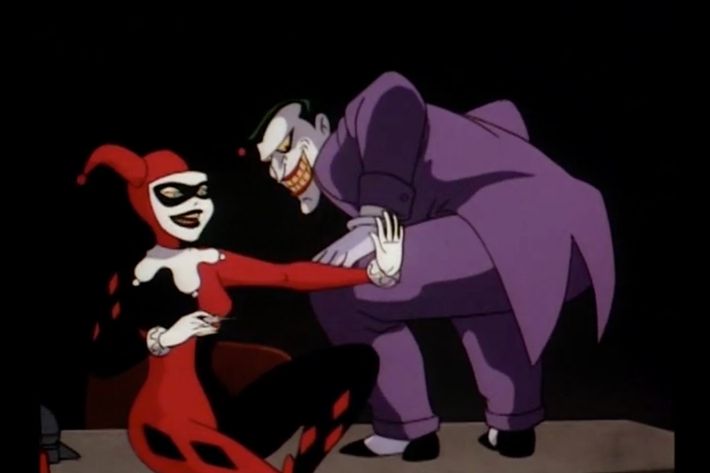
Fans immediately responded to this strange, passionate woman. Tara Strand was about 15 and living in the Podunk town of Victorville, California, when she first saw Harley on The Animated Series, and right away she “felt this big kinship with her.”
“There weren’t a lot of female characters at the time like her who were so human and unique and refreshing and weird, and not just sexy,” she said. “Harley was the one person who can handle what the Joker can dish out. She’s maybe a little masochistic, but the Joker needs somebody who can deal with the Joker, and Harley’s it.”
Strand, like countless other viewers around the world, became Harley Quinn obsessives. She sought out fellow enthusiasts on the nascent World Wide Web and made friends as far away as Germany and Australia. (It’s hard to get a number demonstrating the breadth of ‘90s Harley fandom, but Sorkin, Dini, and Timm all recalled torrents of fan letters.) And for the most part, Strand’s Quinn-thusiast friends were women. Together, they compiled online indexes about Harley and composed long essays about what makes her tick. Building a woman-dominated superhero fandom in the mid ‘90s was a remarkable thing, and Harley had inspired them to do it.
“Feminism is about showing women as fully fleshed out human beings, and that’s what Harley is,” Strand said. “She doesn’t make choices that are smart or good for a woman, but she gets to make those choices. Men are allowed to be fuck-ups in all kinds of characters, and women aren’t. We have to be idealized. She gets to not be.”
DC had a hit on its hands unlike any it’d seen in a long time. Harley was the breakout star of Batman: The Animated Series, and the show was a massive success, giving way to spinoff and tie-in shows that would last until 2006. Harley was a character invented in a non-comics property with little fanfare and very few top-down editorial edicts. But now she was generating a tidal wave of fan response demanding more of her. Toys were made, more episodes penned, and soon she was called up to the big leagues, where she had a meteoric rise — followed by a depressing fall into irrelevance.
The game changer was a concise tale called “Mad Love.” By 1994, Harley fever had caught on, and DC’s comics arm asked Dini and Timm to create a single-issue comics story that would reveal Harley’s origin story. We’d already gotten hints that Harley had once been Joker’s psychiatrist, but in “Mad Love” we fully saw her early days as mild-mannered Harleen Quinzel, gymnast and aspiring mental-health professional. Looking to write a pop-psychology book about the Joker, she falls for him and decides (of her own volition) to become his sidekick.
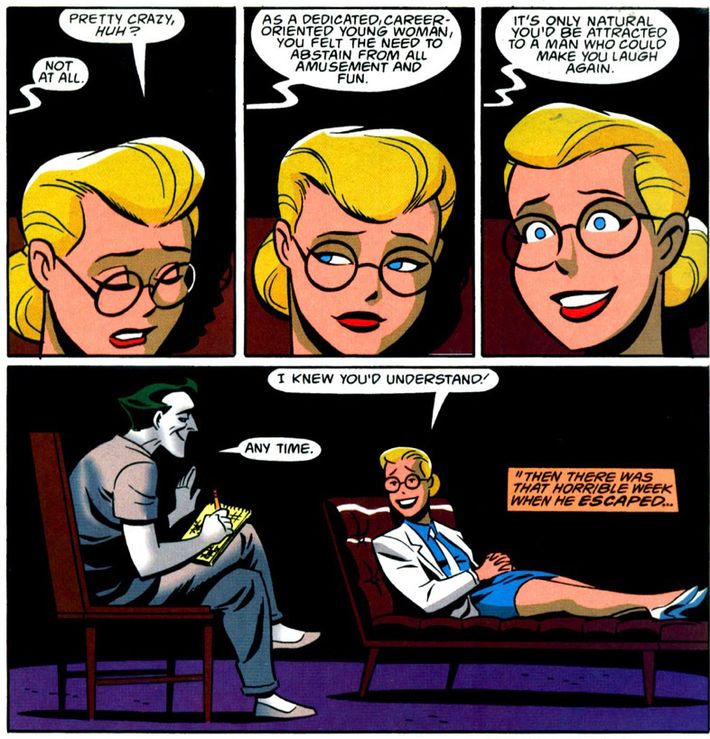
“Mad Love” was a massive hit, winning an Eisner (the comics’ world’s Academy Award) for the year’s best single issue and convincing DC that Harley was a marketable property. Soon Harley was a regular in The Batman Adventures, a comics series set in the universe of The Animated Series. And finally, after years of cartoonish popularity, DC made her a canonical character in the primary Batman comics continuity in 1999. Such continuity is treated with great care, and if a character created outside of it is allowed to enter, it’s no small creative achievement.
In the early aughts, Harley was everywhere. In 2001, she got her own monthly comics series, the eponymous Harley Quinn. The next year she became a recurring character on TV’s Birds of Prey, a loose adaptation of a comics series of the same name. She starred in a goofy web-only animated series called Gotham Girls, which aired as minutes-long Macromedia Flash cartoons. She bounced and laughed her way across DC’s various platforms.
The high times were not to last, though. In the mid aughts, things fell apart for Harley. Her solo comics series was something of a bomb and veered wildly between forgettable fluff, awkward neo-noir, and larger-than-life nonsense. It was canceled in 2003. Elsewhere in mainstream comics continuity, she was used only sporadically, rarely generating the kind of buzz on the page that she’d generated on-screen.
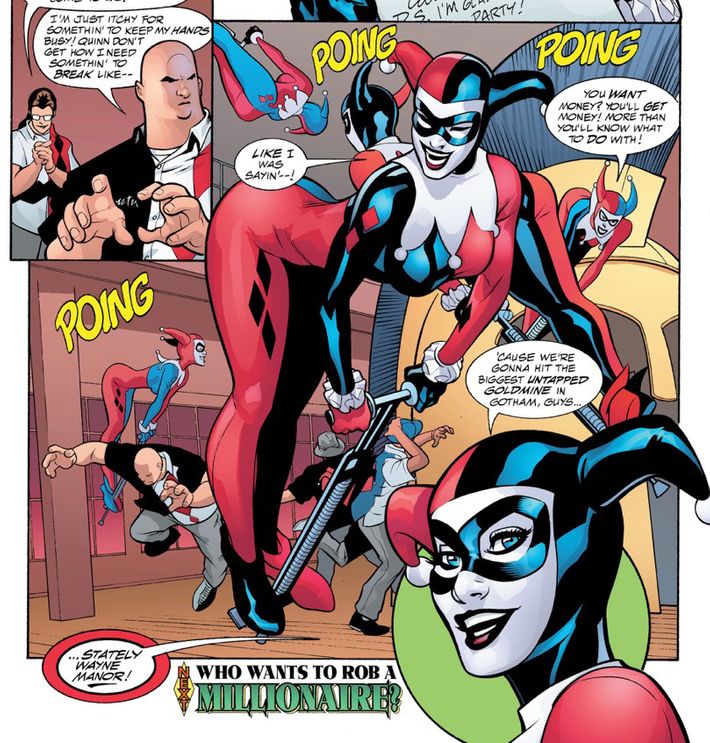
What went wrong? Comics essayist and Batman historian Chris Sims offers a theory. “When you move her into mainstream continuity in 1999, it immediately changes things, because she’s in love with the Joker we have in the comics, not the one in the cartoon,” he told me. “And comics Joker has killed a million people. He’s a sadistic, torturing murderer. You can’t sympathize with her when that’s the Joker she likes.” On the other hand, if you move her away from the Joker, you remove her defining relationship. It would be like writing years’ worth of Joker stories that didn’t involve Batman: empty and confusing.
Then, out of nowhere, Harley’s salvation came from far outside the pages of monthly comics. It was a mixed blessing, as that salvation also set an extremely controversial new template for Harley Quinn, one that would pit fan against publisher as it rocketed the character to her greatest heights of fame to date.
Given her birth outside of comics, it’s oddly fitting that Harley’s rebirth came in another medium, too: video games. In 2009, Rocksteady Studios released an action-adventure beat-’em-up called Batman: Arkham Asylum, and although it was insanely gritty and violent, the creators took their primary inspiration from Batman: The Animated Series. Dini wrote it; Kevin Conroy and Mark Hamill returned to voice Batman and the Joker; and most consequentially, Harley Quinn was a huge character, voiced by Sorkin. Indeed, she’s the only major female character visible for most of the game.
And that visibility is where the great Harley Quinn controversies of the past few years began. Gone was the iconic red-and-black jumpsuit, replaced by thigh-high boots, a red-and-purple corset that barely covers her breasts, and — given that the whole game took place inside an asylum — some scraps of white doctor’s robes, stained with blood. Her face was still painted, but her jester’s cap was replaced by two massive, blonde pigtails. It was, to put it mildly, a very different visual approach to the character.
“There was a huge outcry for a lot of people who really like Harley Quinn,” recalled famed pseudonymous comics journalist “Sue” of the site DC Women Kicking Ass. “It was clearly a little bit of pandering. Does it fit Harley? I don’t know. The Harley Quinn character has always totally run out of fucks to give, so would she mind wearing that? I don’t know.”
Dini and Timm are divided on their feelings about Arkham’s Harley. Dini, as the game’s writer, was very much in favor of the new direction, telling gaming site the Reticule, “I had a large amount of input into the way the characters were depicted, I wanted to make them darker … I wanted to make it clear that Harley Quinn was out of her mind.” Timm, on the other hand, seems far more agnostic: “There must be something to it, because that is, right now, the most popular version of her, I guess,” he told me. “I don’t own the character, so whatever DC wants to do with it is fine with me.”
Throughout the game, Harley assists the Joker in his plot to destroy Batman within the confines of Arkham. She regularly issues classic Dini-esque lines to Batman on her lover’s behalf. Other than her look, the biggest change we see is how much more grim Joker’s verbal abuse of her is. It’s particularly chilling to hear him deliver this line of dialogue to Batman: “You had to spoil everything: beating up Bane, feeding Scarecrow to Croc, slapping around Harley — my hobby, by the way.”
Arkham Asylum was a gargantuan hit. Video games are a massively more influential medium than comics these days (for context: Arkham Asylum sold 2.5 million units within just a few weeks of its debut; the biggest-selling Batman comic of that same month only sold 106,835 copies). Since Harley hadn’t been in any Batman feature films, Arkham Asylum was the single most influential depiction of the character since her Animated Series heyday.
A sequel called Arkham City hit shelves in 2011, and although Harley had her original red-and-black color palette back, the costume was still more dominatrix than clown. She also, for the first time, was no longer voiced by Sorkin, who was replaced by Tara Strong, a longtime DC voice actor who had worked alongside Sorkin for years while doing other voices on DC’s cartoons. (Neither Rocksteady nor Sorkin offered much detail to me about the decision, simply saying the company wanted to shake things up and move in a slightly different direction.)
But the games were just the prelude to an even bigger outcry from fans and critics. The real bone of contention came out of the comics. In 2011, DC kicked off a company-wide relaunch of their comics, rebooting their entire universe and giving many characters a complete makeover. Harley was one such character. She became one of the stars of Suicide Squad, a series about super-criminals hired by the government to go on high-risk black-ops missions. Before the first issue even came out, it caused a furor among longtime fans. The cover prominently featured Harley, hips cocked, hair dyed, and wearing an even more revealing corset than the one she’d worn in Arkham Asylum.
“It’s that classic idea of ‘show us as much skin as possible because it’ll bring in those teenage boys,’” said Laura Hornack, a Harley Quinn superfan from Germany. She launched an online campaign attacking the visual change and even went so far as to organize a protest at 2011’s San Diego Comic-Con. Turnout wasn’t great, but she wasn’t alone in her skepticism about the character’s direction.
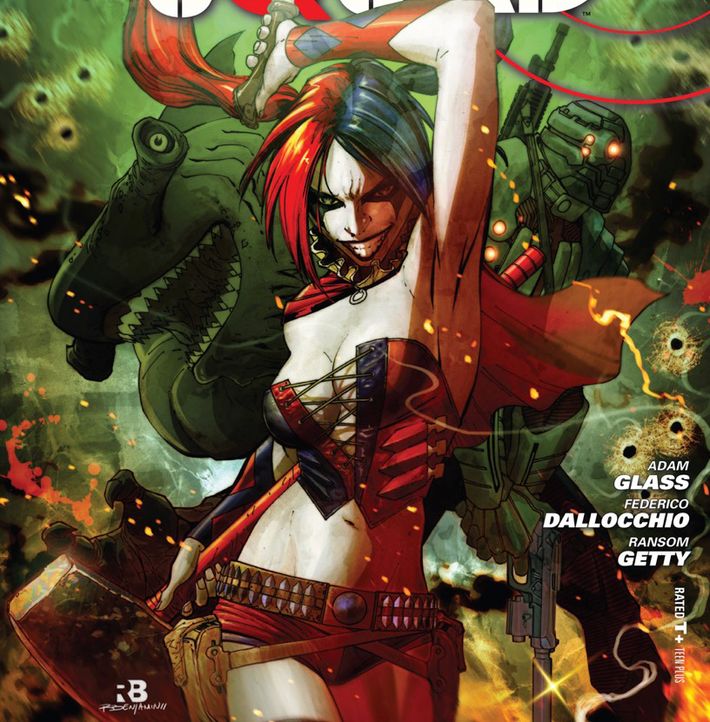
In Suicide Squad, Harley was a somewhat different animal from her classic depiction. She was still in love with the Joker, but thought he’d been killed, so we mostly saw her palling around with her fellow Squad members — even hooking up with stoic assassin Deadshot. She was more of a psychopath than usual, grinning as she executed bloody murders and giggling in situations where even her hardened teammates were terrified. The book was, for the most part, critically panned and canceled after 30 issues. She remained massively popular in the continuing installments of the Arkham video-game series (she even got her own spinoff game, Harley Quinn’s Revenge, in 2012), but her comics persona was in crisis.
In 2013, DC wisely tried to turn a new leaf with Harley. The company announced it’d be launching a new solo Harley Quinn series and hired acclaimed husband-and-wife duo Amanda Conner and Jimmy Palmiotti to write it. The series got off to a rocky start because of a poorly worded contest and subsequent bout of bad press for the first issue. But to DC’s relief, future issues have drawn no such ire. In fact, the series has taken a cute and experimental new direction for the character, unlike any she’s ever had. Conner and Palmiotti have had Harley strike out on her own after a rejection from the Joker, and she’s moved to a place well known for housing over-the-top eccentrics: Coney Island (New York City does, indeed, exist in the DC universe, although it’s not as major a city as Metropolis or Gotham).
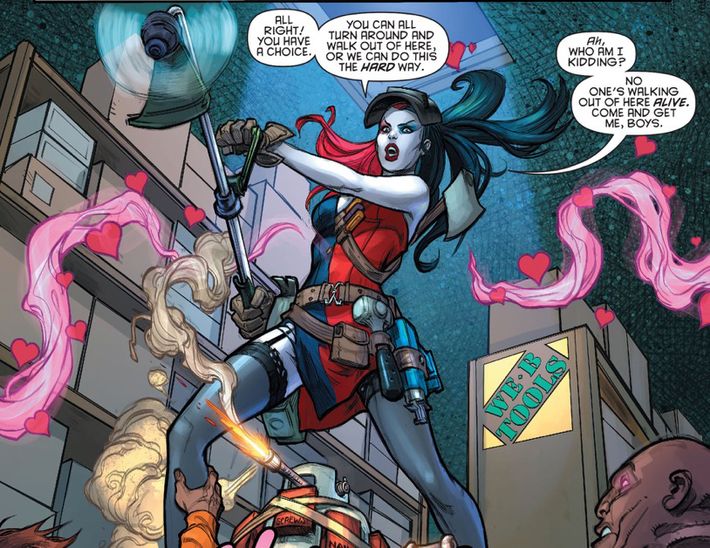
There, she channels her aggression into roller-derby competitions, gets a day job as a therapist, and assembles a diverse cast of weirdos and outcasts around her. She’s still pretty bonkers, but she doesn’t look or act like a fetish fantasy anymore. She’s coming into her own, and the writers try to channel what made her great into slightly more healthy outlets.
The formula is working, at least financially: Harley Quinn is consistently one of DC’s top-selling comics. The character’s popularity is also soaring in other mediums, most notably with her upcoming big-screen debut in 2016’s Suicide Squad movie, where she’ll be played by Margot Robbie. She’s still a major figure in the Batman world’s most lucrative products, the Arkham video games, as well as DC Entertainment’s extremely popular Injustice video-game series. Though she may have evolved substantially since that fateful cameo in “Joker’s Favor,” Harley has never been more successful, and her star shows no signs of falling.
And although there are longtime diehards like Strand and Hornack who have abandoned DC’s current iterations of Harley, they should know they have ideological allies in her current comics stewards, Palmiotti and Conner. The writing team considers Harley a feminist character, drawing comparisons — and contrasts — between her and comics’ longest-standing female icon, Wonder Woman. “Wonder Woman sort of represents perfection, whereas Harley represents everybody else,” Conner said.
One of the biggest Harley fans I’ve encountered is an Australian named Elise Archer, who’s been a fan since the early days and says her fixation on Harley has helped her through her own battles with PTSD and clinical depression. She was adamant that Harley was one of the most important feminist figures in superhero fiction — not in spite of her shortcomings, but because of them.
“I don’t want to be condescended to with strong, independent female characters who don’t have any flaws and are just kinda perfect and sane and never make bad relationship choices,” she said. “For me, the freedom Harley’s been given to be a fuck-up is much less misogynist than all these other hackneyed stories thrust on female characters again and again.”
“If you want to make the argument that we’ve gotta teach people how to be good and healthy, do it with the fuckin’ heroes,” Archer said, her voice quivering with emotion. “Let the villains be the messy ones.”
